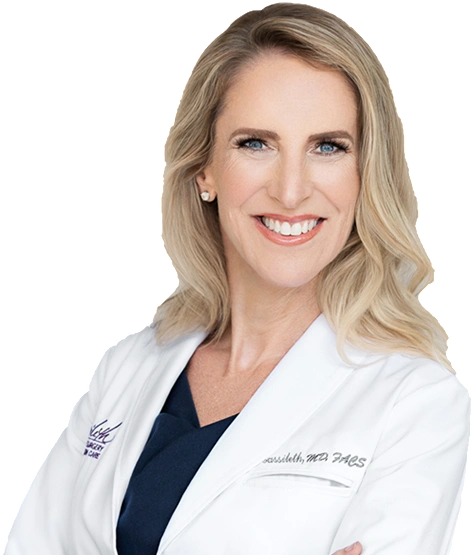
Breast Reconstruction Revision
Get a Natural Look After Mastectomy in Beverly Hills
Every woman who has had breast reconstruction following mastectomy surgery should love her results and feel comfortable in her body. Unfortunately, for most patients this is not the case. According to The American Society of Plastic Surgeons, breast implants are used in roughly 80% of traditional mastectomy breast reconstruction surgeries, however implants in the reconstructed breasts are often visible, feel unnatural and/or cold, uncomfortable, and asymmetric. 1
When it comes to unilateral breast reconstruction, differences between the reconstructed breast and the natural breast are obvious immediately, and only increase with time. Patients who have undergone previous breast reconstruction surgery can improve their initial results and their quality of life with breast reconstruction revision at Cassileth Plastic Surgery in Beverly Hills.
Dr. Lisa Cassileth, and Dr. Kelly Killeen employ state-of-the-art surgical techniques to make dramatic improvements to your mastectomy result. Breast reconstruction revision can help breast cancer patients feel confident and whole again—even for those who have been told they are out of options.2 We address everything from deep problems, such as the pain, muscle imbalance, and shoulder and back problems that come from cut pectoralis and serratus muscles, to more superficial problems such a symmetric and soft appearance. We also address health problems and deformity that may stem from reconstruction with prior infections, skin healing problems, and BII.
Contact Cassileth Plastic Surgery about capsular contracture in Los Angeles, Beverly Hills, Santa Monica, and beyond.
Browse our plastic surgery before and after photos to see real-life results on breast reconstruction revision patients just like you. Every breast augmentation surgery, including all breast reconstruction procedures such as implant reconstruction, diep flap reconstruction and autologous reconstruction yields a unique result, but viewing our before-and-after photo gallery is an ideal way to see the exceptional outcomes our highly experienced plastic surgeons can achieve.
Every surgery will yield unique results, but before-and-after images are an excellent way to see the quality of natural-looking outcomes our experienced plastic surgeons are capable of providing.
See More Results
Dr. Kelly Killeen is not just an outstanding surgeon and artist, she is also an angel. I had 15+ surgeries to correct an ongoing problem for last 10 years, numerous super-famous doctors worked on me, in different parts of the world, including Geneva, Berlin, etc.. So by the time I got into Dr. Kelly's hands the words "total mess" don't even begin to describe the actual condition of what used to be my breasts. Dr. Killeen, just as regular angel performed a miracle and made everything good again. I love you. There is also nurse Dee who is just incredible human being, here level of compassion, love and care is truly rare. Last but not the list there is a Brit called Jade - she is so beautiful, funny and totally awesome, I will find a reason to come again for some facial peeling or something else simple just to see you guys! I am so blessed to have met these beautiful people, they maybe just part of exceptional medical team, but in my heart they will always be my friends...
Patients with unilateral mastectomy may find that the newly constructed breast sits higher on the chest wall and looks less natural than the natural breast. We can make the reconstructed breast look more natural, while making the natural breast look more symmetric by creating lift and upper fullness. We do this using a combination of liposuction and fat transfer to add volume to the reconstructed breast, creating a natural layer of fatty tissue. This not only hides the edges of the implant, but makes the entire reconstruction look more natural. When it comes to the remaining natural breast, we often enhance symmetry with a breast lift and augmentation with an implant to achieve two breasts that have a similar youthful appearance.
This breast reconstruction revision strategy achieves beautiful results that are also longer lasting, because they both contain fat and implants so they will age at a similar pace. Some patients prefer to avoid implants on the “real” side, and for those patients Dr. Cassileth recommends a pocket lift, in which breast tissue is supported by an internal pocket next to the pectoralis fascia, which does a better job holding up a lifted breast long term
Board-Certified Beverly Hills Plastic Surgeon, Breast Specialist, and Direct-to-Implant Breast Reconstruction Inventor
Capsular contracture occurs when a hard capsule of scar tissue forms around a breast implant and constricts the implant to the extent that it causes the breast to feel like it’s encased in a hard shell. Severe cases of capsular contracture can cause the breast to look misshapen and be painful.
Using a breast reconstruction revision procedure called a capsulectomy can correct capsular contracture. This surgery requires removing the breast implant from the breast pocket and then removing the capsule of scar tissue entirely. Once the capsule has been removed, we place an acellular dermal matrix in the excised breast pocket to create a structure that is more natural-looking—and functions much like an internal bra. This additional support allows the breast implant to sit in the correct position and minimizes the chances of forming new scar tissue following breast reconstruction revision surgery.
This is a highly successful surgery which is typically combined with low volume fat grafting for best results. This can be performed on radiated breasts. Capsular contracture patients must also be tested for biofilms, which are low grade bacterial contaminations of the implants that must be eradicated for cure. 3
Double-Board-Certified Beverly Hills Plastic Surgeon and Breast & Body Specialist
A common mastectomy outcome following unilateral breast reconstruction is a breast with a visible and unsupported implant, which can move out of position and feel heavy. Patients with bilateral implants may find that low or unsupported implants have a noticeably wide distance between them, creating an upper chest that is hollow-looking with visible rippling of the implants.
This is primarily an implant support problem. Most of these patients need a strong internal bra-like support structure to the capsule to keep the implant in position. For most patients, we use absorbable mesh to build this internal support, which does not stretch over time as much as acellular dermal matrix. We’ll also typically use cohesive gel implants as their composition minimizes visible rippling. The final step of this type of breast reconstruction revision is to add fat harvested from a donor site above and between the breasts. This provides a full and natural appearance while avoiding a visible implant step-off and cleavage gap issues.
Many mastectomy patients are sick of their implants, which may be painful, feel foreign, need to be replaced over time, or are concerned for health issues. Implants can be replaced by fat over time using serial fat grafting, and reducing the size of the implant and ultimately removing any silicone device. The surgery can take place in different ways, and it depends on the patient. For patients with very large implants, the implant is swapped for a tissue expander, and fat graft is added to the mastectomy flap. Fat is then added to the mastectomy flap, and the tissue expander is deflated with each additional mini-surgery, until the expander is flat and can be removed.
For patients with smaller implants, the total volume is lower, which makes the replacement with fat easier. In this case, the implant size is usually diminished once with a fat grafting surgery, and then the implant is removed in the subsequent surgery.
For all patients hoping to remove their implant and replace them with fat, there does need to be adequate fat on the body to harvest and place in the mastectomy flap. A good rule of thumb is that the fat in the breast area can be doubled with each surgery. Therefore, the first fat graft is the smallest amount that is placed, followed by larger and more significant amounts with each surgery and more impressive results. The surgeries are usually done 6 months apart, which allows adequate time for the fat to permanently live in the new location. Most patients require between two and four surgeries. Patients with submuscular implants will also require repair of their pectoral muscles for complete reconstruction, which is typically done on implant removal. Patients with a history of radiation are excellent candidates for replacement, as the fat graft has not been radiated and will typically restore a more normal appearance and feeling to the radiated breast.
The consultation process is the most important part of surgery preparation. When you meet with one of our experienced breast surgeons, you will have the opportunity to discuss your concerns, get answers to any questions you have, and learn more about your options. Your surgeon will review your medical history and perform an exam. Then they will work with you to craft a treatment plan that is custom-tailored to your needs and goals.
It is important to stop smoking and all nicotine products several weeks before your surgery. You may also need to stop using certain medications. Our team will give you a detailed list of pre-surgical instructions and we’ll be available to answer any questions.
Breast reconstruction revision procedures are performed under general anesthesia. The specific surgical techniques used during your surgery will vary depending on what type of surgery you have. Your surgeon will review your treatment plan with you in detail to ensure that you understand exactly what will happen in the operating room. Our team will make sure you feel fully prepared going into surgery.
The recovery process after breast reconstruction revision surgery varies depending on the specific procedure and the extent of the revision. Generally, patients can expect to experience some pain, swelling, and bruising for several days to a few weeks after the surgery. Patients may need to limit physical activities and avoid lifting heavy objects for several weeks. Your surgeon will provide specific instructions on post-operative care and follow-up appointments.
Breast reconstruction revision surgery is a surgical procedure that aims to modify or improve the results of a previous breast reconstruction surgery. Our board-certified plastic surgeons are experts in breast reconstruction and are skilled in a range of surgical techniques. We offer many types of reconstruction revision surgery and our surgeons will work with you to find the treatment plan that is best for you.
Common reasons for breast reconstruction revision surgery include implant rupture, implant malposition, implant displacement, capsular contracture, implant rippling or wrinkling, implant visibility or palpability, implant asymmetry, skin or nipple-areola complex (NAC) malposition, skin laxity or excess, and dissatisfaction with the initial results.
The timing for revision surgery depends on the specific issue and the healing process. Generally, it is recommended to wait for at least six months after the initial surgery to allow for proper healing and stabilization of the breast tissues. However, in some cases, revision surgery may be performed earlier if there is a complication or issue that requires immediate attention.
Insurance coverage for breast reconstruction revision surgery varies depending on the specific policy and the reason for the revision surgery. If the revision surgery is medically necessary, such as in cases of implant rupture or capsular contracture, it may be covered by insurance. However, if the revision surgery is elective or cosmetic in nature, it may not be covered.
If you would like to learn about your breast reconstruction revision options, please contact us today. We’d be happy to assist you by answering any questions you may have and schedule your personal consultation.
Arrange a consultation for capsular contracture treatment at Beverly Hills' Cassileth Plastic Surgery. Women from Santa Monica, the entire Los Angeles area, and beyond can Send a message online or call (310) -278-8200.
1American Society of Plastic Surgeons. 2019 Plastic Surgery Statistics. Available: https://www.plasticsurgery.org/documents/News/Statistics/2019/plastic-surgery-statistics-full-report-2019.pdf. Accessed September 17, 2021.
2 American Society of Plastic Surgeons. Immediate Breast Reconstruction Reduces Psychological Impact of Mastectomy. Available: https://www.plasticsurgery.org/news/press-releases/immediate-breast-reconstruction-reduces-psychological-impact-of-mastectomy. Accessed September 17, 2021.
3 Breast Cancer. Reducing infection risk in implant-based breast-reconstruction surgery: challenges and solutions. Available: https://www.ncbi.nlm.nih.gov/pmc/articles/PMC5012596/. Accessed September 17, 2021.
Connect with us on social media! We pride ourselves on building real relationships with our patients near and far.

